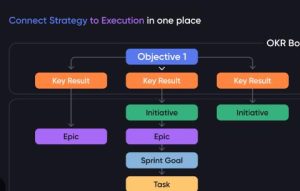How Do OKR and Agile Complement Each Other?
The combination of Objectives and Key Results (OKRs) and Agile methodologies is becoming increasingly popular in dynamic business environments where adaptability and precise goal-setting are crucial. Together, OKRs and Agile create a powerful synergy that enhances strategic planning, execution, and team dynamics. This article explores how these two methodologies complement each other, leveraging their strengths to drive business success.

Strategic Focus and Iterative Execution
OKRs Provide the Direction; Agile Paves the Path
OKRs set clear, measurable goals that define what success looks like for an organization. These goals are ambitious and challenge the organization to stretch beyond its current capabilities. Agile methodologies, known for their iterative, sprint-based approach, provide the framework to achieve these goals through continuous delivery and improvement.
For instance, a company may set an OKR to “Increase market share by 30% within the next year.” Agile teams would break down the key results necessary to achieve this objective into smaller, manageable tasks to be tackled over multiple sprints, adjusting tactics based on feedback and results from each iteration.
Enhanced Flexibility and Responsiveness
Adapting to Change
Agile methodologies thrive on their ability to adapt to change, a quality that complements the dynamic setting of OKRs. As market conditions shift or new challenges arise, Agile teams can pivot quickly, ensuring that the strategic objectives set out in OKRs remain relevant. This adaptability is crucial, given that 74% of organizations report that Agile helps them adapt to changing requirements more efficiently.
Continuous Feedback Loop
The sprint reviews and retrospectives in Agile provide regular feedback, essential for evaluating the effectiveness of current strategies and making necessary adjustments. This continuous feedback loop ensures that the efforts of Agile teams are consistently aligned with the strategic OKRs, maximizing resource utilization and efficiency.
Alignment and Transparency Across Teams
Breaking Down Silos
OKRs foster transparency across the organization by making objectives and key results visible to all teams. This visibility ensures that everyone understands how their work contributes to the larger goals, enhancing alignment across various departments. Agile practices support this by promoting collaboration across cross-functional teams, further breaking down silos.
Shared Understanding and Commitment
The regular check-ins required in both OKR and Agile frameworks ensure that all team members are on the same page and committed to the organization’s goals. Studies show that teams that regularly align their goals through OKRs and Agile practices see a 20% increase in achievement of strategic outcomes compared to those that do not.
Cultural Synergy
Fostering a Culture of Innovation and Continuous Improvement
Both OKRs and Agile encourage a culture of experimentation and learning. OKRs push teams to set challenging goals, while Agile methodologies provide a safe environment to experiment with new ideas without fearing failure. This combination not only drives innovation but also promotes continuous learning and development among team members.
Empowering Teams
Agile methodologies empower teams by giving them the autonomy to manage their work and make decisions within the framework of the organization’s goals. OKRs complement this by providing clear direction and measurable results that guide these decisions, ensuring that they contribute to the organization’s strategic vision.
To explore more about how OKR and Agile methodologies work together to enhance organizational performance and agility, visit the comprehensive guide. This synergy not only improves efficiency and execution but also cultivates a proactive, engaged, and results-oriented workplace culture.